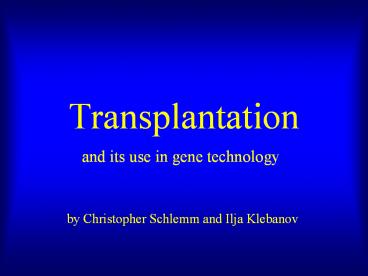Transplantation PowerPoint PPT Presentation
Title: Transplantation
1
Transplantation
- and its use in gene technology
by Christopher Schlemm and Ilja Klebanov
2
Structure
- Introduction
- General information
- Methods of transplantation
- 3.1 Autografting
- 3.2 Allografting
- 3.3 Xenografting
- Problems of transplantation
- Gene technology as a solution
- 5.1 Organ breeding
- 5.2 Suppression of
- rejection
- 5.3 Ideas for the future
- Conclusion
3
General information
Definition to transfer a graft (an organ or
tissue) from one part or individual to another
- May take place between
- different parts of the same organism
(autografting) - different organisms of the same species
(allografting) - different species
- (xenografting)
4
Immune system rejection
General information
- Often a transplanted organ is not identified by
the immune system as the tissue of the organism - ? It can be attacked and destroyed.
- Against this effect the patient has to swallow
Immunesuppressiva which cause symptoms like
suffering from AIDS. - In 15-20 minutes the organ dies, unable to
withstand the immune system attack.
Rejection of a heart
5
Autografting
Methods of Transplantation
- The transfer of self tissue from one body site to
another in the same individual - Due to the genetic homology of the tissue, the
immune system does not respond to it - Use synthetic implantation
- skin grafts
- bone marrow transplantation
- hair
6
Allografting
Methods of Transplantation
- Definition The transfer of organs or tissue
from human to human or from cadaver to human - As there are more and more people every year
waiting for donor organs and tissues,
allografting transplantation has become quite
common. - Allografting transplantation has many
applications.
7
Allografting
Applications of allografting transplantation
8
The importance of transplantation
Allografting
9
Xenografting
Methods of Transplantation
- Definition Xenotransplantation the transfer
of tissue from one species to another - Usually refers to the implantation of animal
tissue in humans - provides a new source of organs for humans
- many different types of tissue can be
transplanted - e.g. heart, kidney, liver or lung
10
From which animals are we able to transplant
organs
Xenotransplantation
1. The Chimpanzee Its DNA sequence differs from
ours by only 2
2. The Baboon Its organs are too small for a
large adult human
3. The Pig Surprisingly similar too our anatomy
and physiology
11
Problems of Transplantation
- There are not enough organs
- At least 150,000 patients in industrially
developed countries badly need donor organs and
tissues - Every 14 minutes another name is added to the
national transplant waiting list. - About 16 people die because of the lack of
available organs for transplant each day. - Rejection
- When the immune system of the host detects
foreign graft tissue, it launches an attack,
resulting in tissue rejection
12
Gene technology as a solution
What is possible using gene technology refering
to the problems?
- Gene technology offers the possibility to breed
the desired organs in animals. - Lack of organs is no longer a problem
- Gene technology makes it possible to humanize the
bred organs - the immune system identifies the
organ as its own tissue. - Immune system rejection is prevented
13
Gene technology - transgenic animals
Gene technology as a solution
- Organ breeding
- A transgenic animal carries a foreign gene that
has been inserted into its genome. - The transgenic animal shows the specific
characteristics which are coded on the inserted
gene - ? A gene which is responsible for the
construction of a human organ makes the organism
produce the organ additionally.
14
The insert of a foreign gene into an animal
Gene technology as a solution
I. DNA microinjection The DNA is inserted into
the cell with a small syringe
II. Retrovirus gene transfer The DNA is carried
into a cell by a virus. The virus carries the
desired DNA and infects the cell, which has the
effect that the DNA is built into the cells DNA.
15
Suppression of immune system rejection
Gene technology as a solution
The immune system has the task to protect the
organism against every foreign cell. The immune
system distinguishes between cells of the body
and foreign cells. The genes which are
responsible for the own tissue not being rejected
can be injected into an animal embryo the organs
of which are then similar to the ones of the
human.
Not rejected pancreas
It is possible to humanize the bred organs by
making certain genetic modifications. Then the
organs are accepted by the immune system.
16
Ideas for the future
Gene technology as a solution
- Organ breeding by using stem cells
- Stem cells are able to become any cell which is
found in the human. Under specific conditions
stem cells could become cells of a kidney, a
brain and so on. - Thus by using one stem cell from an embryo a
whole new organ could be created.
Embryo
Stem cell
Cell differentiation
17
Conclusion
- During the era of gene technology transplantation
has improved very much - In future donors wont be needed any longer
- Scientists will be able to breed organs and to
adapt them to the organism of the patient - Most of the ethnical problems will be eliminated

